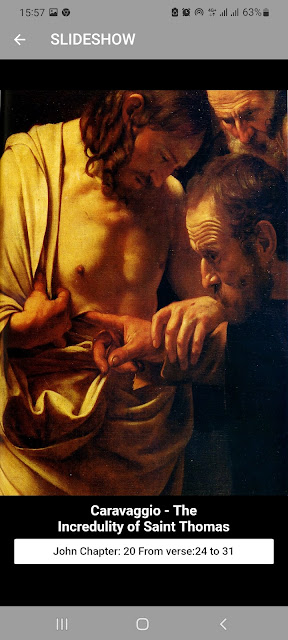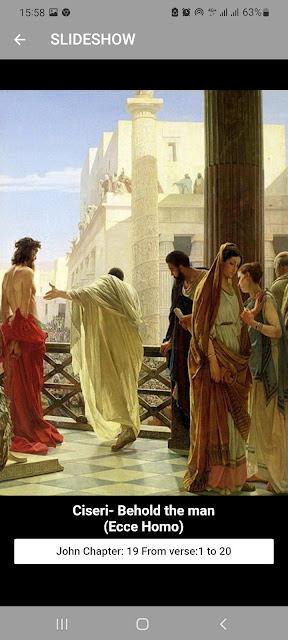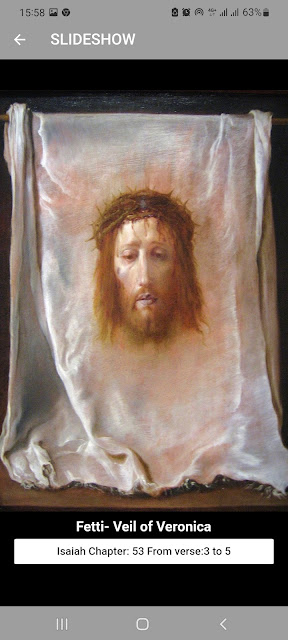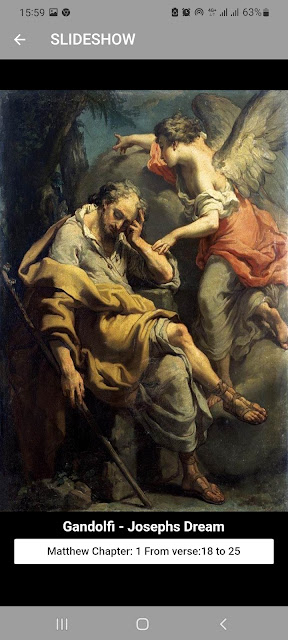Our Classical biblical paintings app for iphone and android has about 1,000 paintings. Additionally, each painting has a link to the bible reference that inspired it.
Below is a sample of some images and an exposition.
Our Classical biblical paintings app for iphone and android has about 1,000 paintings. Additionally, each painting has a link to the bible reference that inspired it.
Below is a sample of some images and an exposition.
1. Batoni The Prodigal Son Luke 15:11-32
1. Batoni The Prodigal Son Luke 15:11-32
I think this is a beautiful depiction of a father's love for his child. The son was greedy and impertinent, doing what is unconscionable, demanding one's birthright while the parents are living; I would say unforgivable.
I think this is a beautiful depiction of a father's love for his child. The son was greedy and impertinent, doing what is unconscionable, demanding one's birthright while the parents are living; I would say unforgivable.
2. Battista handing the keys to St Peter Matthew 16:19-21
3. Bergers - Adoration Matthew 2:1-12
The Nativity or birth of our Lord has significant
implications for Christians and the world as a whole. Some of the most
significant implications of the Nativity include:
Salvation: The Nativity is the fulfilment of God's promise
to send a Savior to redeem humanity from sin and death. His birth marks the
beginning of a new era of salvation and hope, and it is through his life,
death, and resurrection that people can be forgiven and reconciled to God.
Incarnation: The Nativity represents the moment when God
became flesh and dwelt among humanity. This event is known as the Incarnation
and it is a central belief of the Christian faith. Through the Incarnation, God
reveals himself to humanity in a tangible way, demonstrating his love and
concern for people.
Love and compassion: The Nativity demonstrates God's love
and compassion for humanity. His birth in a manger, surrounded by animals,
shows God's willingness to humble himself and to reach out to people in their
need. The story of the Nativity also highlights the themes of compassion, love,
and generosity, as it is often accompanied by stories of the shepherds and the
wise men who bring gifts to the newborn baby.
Unity: The Nativity has the potential to bring people
together, regardless of their background, culture, or beliefs. It is a story
that transcends national and cultural boundaries, and it is celebrated by
Christians all over the world. The birth serves as a reminder of the
unity that is possible among all people.
Hope: The Nativity represents hope for humanity. His birth represents a new beginning and a new hope for people, and it is a
reminder that God is present and active in the world. Through the Nativity,
people are encouraged to hope for a better future, both for themselves and for
the world as a whole.
The Nativity of Our Lord is a significant event that has far-reaching implications for Christians and the world. It represents salvation, the Incarnation, love and compassion, unity, and hope, and it serves as a reminder of the transformative power of God's love and grace.
4. Carravagio The incredulity of St Thomas John 20:24-31
5. Carravagio Conversion on the way to Damascus Acts 9:1-19
First, you fall off your self-righteous horse, and then you start again. A beautiful story of self-righteousness turned to being downtrodden, then to being a Saint. God bless you Saul, our St Paul, the Disciple to the Gentiles!
The conversion of Paul is considered one of the most
significant events in the early Christian church. Saul, who was also known as
Paul, was born a devout Jew and was a Pharisee, a member of the religious and
political elite in Jerusalem. He was known for his zeal and commitment to his
faith and was instrumental in the persecution of the early Christians.
However, on his way to Damascus to arrest and bring back to
Jerusalem any followers of Christ, he had a life-changing experience. According
to the New Testament, he was struck blind by a bright light and heard the voice
of Christ asking him why he was persecuting Him. This experience transformed
Saul from a fierce opponent of Christianity into one of its greatest advocates.
After his conversion, Paul began to spread the message of
Christianity to the Gentiles, people who were not Jews. He travelled extensively,
visiting many cities and establishing new Christian communities. He also wrote
several letters, many of which were later included in the New Testament, that
provided important insights into the nature of Christ, the role of faith, and
the relationship between Jews and Gentiles in the Christian community.
One of Paul's most important contributions to early
Christianity was his teaching that salvation was available to both Jews and
Gentiles, not just to Jews. This message helped to unite the early Christian
communities and was a key factor in the growth and spread of Christianity.
Overall, the conversion of Saul of Tarsus had a profound impact on the early Christian church and continues to shape the beliefs of Christians around the world today. It demonstrates the transformative power of faith and serves as a powerful testimony to the transformative power of God's love and grace.
6. Cavalier Christ was taken prisoner Matthew 26:47-56
This happened in the garden of Gethsemane, where Judas betrayed the Lord with a kiss. In the painting, St Peter cuts off the ear of Malthus, a servant of the high priest. The Lord would, however, have none of it, and restored the ear, whilst also agreeing to be arrested; it was after all part of the larger design.
7. Ciseri "Ecce Homo" - Behold the man John 19:1-20
"Ecce Homo," or "Behold the Man," is a
phrase from the Gospel of John, about Jesus of Nazareth. In the context of the
story, the phrase was used by Pontius Pilate, the Roman governor of Judea, when
he presented Jesus to the crowd before his crucifixion. Pilate intended to
demonstrate that Jesus was a political prisoner and not a threat to Roman rule.
In Christian art and theology, "Ecce Homo" has
taken on a broader significance, representing the humanity of Jesus and his
willingness to sacrifice himself for the salvation of humanity. The phrase has
been used to reflect on His humanity, emphasizing his physical and
emotional suffering, and his ultimate sacrifice on the cross.
For many Christians, "Ecce Homo" serves as a
powerful reminder of the Lord's love and compassion for humanity. It is a call to
remember the sacrifice that Jesus made for all people and to respond with
gratitude, devotion, and obedience to God. In this sense, "Ecce Homo"
is a reminder of the centrality of the cross in the Christian faith, and of the
importance of reflecting on the sacrifice of Jesus in one's daily life.
In addition to its spiritual significance, "Ecce
Homo" has also been the subject of artistic expression, with many famous
works of art depicting the phrase or the moment in which Pilate presents Jesus
to the crowd. These works often serve to deepen the religious and cultural
significance of "Ecce Homo" and to inspire contemplation and
reflection on the humanity of Christ and the sacrifice he made for all people.
8. Eugeniusz Divine Mercy Romans 9:1-33
The Divine Mercy image is a religious depiction of Christ that has become a popular devotional object for many Roman Catholics.
The image was originally painted by a Polish artist, Eugeniusz Kazimirowski, in
1934, and is based on the visions of Saint Faustina Kowalska, a Polish nun who
lived in the early 20th century.
In her visions, Saint Faustina saw Jesus with rays of light
shining from his heart, symbolizing the divine mercy that he offers to all
people. The rays in the image are typically depicted as red and white, with the
red representing the blood of Christ and the white representing the water of
baptism. The image usually features the words "Jesus, I trust in You"
written above the image of Christ.
For many Roman Catholics, the Divine Mercy image is a
powerful symbol of the love and forgiveness that Jesus offers to all people. It
is often used as a focus for prayer and meditation and is associated with many
devotions and liturgical celebrations, including Divine Mercy Sunday. Many
people find comfort and solace in contemplating the image and believe that it
helps them to deepen their relationship with Christ and to experience his mercy
in their lives.
In addition to its spiritual significance, the Divine Mercy
image has also become a popular cultural icon, with many reproductions and
adaptations of the original image available in various forms, including prints,
medals, rosaries, and other religious objects. The image has been embraced by
people from a variety of cultures and backgrounds and continues to be a source
of inspiration and comfort for millions of people around the world.
9. Fetti Veil of Veronica Isaiah 53:3-5
Over the centuries, the Veil has become a
powerful symbol of the passion of Jesus and the suffering that he endured for
the salvation of humanity. It is often used as a focus for meditation and
devotion and is revered by millions of people around the world.
The authenticity of the Veil has been the
subject of much debate over the centuries, with some scholars and historians
questioning its historical origins. However, for many Roman Catholics, the Veil
of Veronica is a powerful and meaningful religious symbol, regardless of its
actual history.
In art, it is often depicted as a cloth
with an image of Jesus' face on it and is sometimes shown being held or
displayed by Veronica. Many famous works of art have depicted the veil,
including paintings, sculptures, and stained glass windows, and it continues to
inspire artists and religious devotees today.
10. Josephs dream Matthew 1:16-25
The dream of Joseph is described in the Gospel of Matthew.
According to the account, Joseph was betrothed to Mary but had not yet
consummated the marriage when he learned that she was pregnant. Joseph was a righteous
man and was concerned about how he would explain the pregnancy to others, as he
did not want to expose Mary to public disgrace.
In a dream, an angel of the Lord appeared to Joseph and told
him not to be afraid to take Mary as his wife, because the child she was
carrying was conceived by the Holy Spirit. The angel also told Joseph that the
child was to be named Jesus and that he would be the Savior of the world.
This dream played a significant role in Joseph's decision to
take Mary as his wife and accept Jesus as his son. It also helped to reassure
Joseph that he was doing the right thing, despite the potential public shame
that he and Mary might face as a result of the pregnancy.









